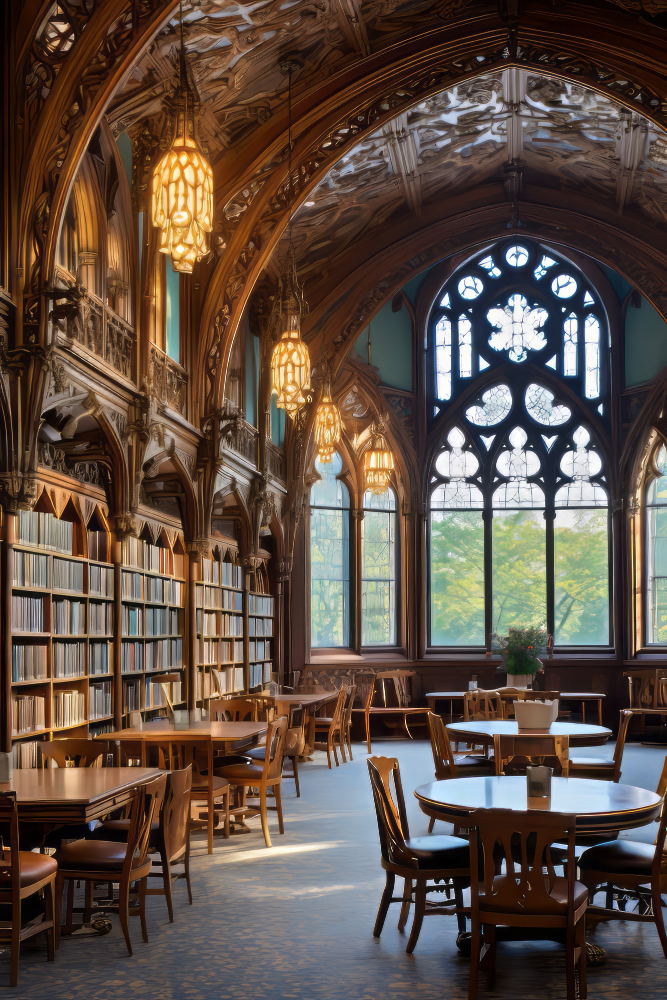
Welcome to a journey through one of Oxford’s most revered institutions—the Bodleian Library history.
Whether you’re a history buff, a literature enthusiast, or simply curious about iconic landmarks, the Bodleian Library offers a wealth of intrigue and scholarly marvels.
Let’s delve into its rich history, rare collections, and captivating facts that make it a must-visit destination in Oxford.
What Makes the Bodleian Library a Cultural Gem?
Nestled in the heart of Oxford, the Bodleian Library history stands as a testament to centuries of academic pursuit and intellectual curiosity.
Here’s why it captivates visitors from around the globe:
- Historical Roots: Founded in 1602, the Bodleian Library has roots that stretch back over four centuries, steeped in the history of academia and knowledge preservation.
- Architectural Marvel: Its stunning architecture, with buildings ranging from medieval to modern, offers a visual feast for architecture aficionados and history lovers alike.
- Rare Collections: Housing over 13 million items, including rare manuscripts, maps, and first editions, the Bodleian Library is a treasure trove for researchers and scholars.
The Birth of an Iconic Institution
The Bodleian Library exists thanks to Sir Thomas Bodley. He was an English diplomat and scholar who dedicated himself to reviving the Oxford University Library after retiring from public life.
The library was initially established in the 14th century; however, it fell into disrepair over time.
Recognizing the importance of a well-maintained library for scholarly work, Bodley invested his own resources. He also solicited donations to rebuild and restock the library, officially reopening it in 1602.
- Sir Thomas Bodley: A Renaissance man, Bodley’s vision for a world-class library has endured for over 400 years, reflecting his passion for knowledge and learning.
- Initial Collections: Bodley’s connections and persistent fundraising efforts brought in numerous valuable books and manuscripts, setting a high standard for the library’s future acquisitions.
Architectural Evolution Through the Centuries
The architectural history of the Bodleian Library is a journey through time. It showcases styles from different eras, creating a unique and inspiring environment:
- The Old Library (Duke Humfrey’s Library): The oldest part of the Bodleian, dating back to the 15th century, Duke Humfrey’s Library is a Gothic masterpiece with wooden beams and intricately carved bookcases. It served as the foundation for Bodley’s vision.
- The Radcliffe Camera: An iconic part of the Oxford skyline, this neoclassical rotunda was completed in 1748. It now functions as a reading room, blending beauty and utility.
- The New Bodleian (Weston Library): Opened in 1940, this modern extension reflects the library’s continuous growth. It was renamed the Weston Library after a major renovation completed in 2015, which added state-of-the-art facilities while preserving its historical essence.
Unveiling the Treasures Within
Imagine perusing Shakespeare’s First Folio or Newton’s personal annotations—these are just a glimpse of what awaits at the Bodleian Library.
Here’s a deeper dive into some of its most prized collections:
- Shakespeare’s First Folio: The library proudly houses a copy of Shakespeare’s First Folio, a literary cornerstone showcasing the Bard’s enduring legacy. This 1623 publication is one of the most important works in English literature, preserving many of Shakespeare’s plays that might otherwise have been lost.
- Newton’s Principia Mathematica: Sir Isaac Newton’s personal annotated copy of his groundbreaking work resides here, offering insights into the mind of a scientific genius. This work laid the foundations of classical mechanics and has been pivotal in the history of science.
- The Gutenberg Bible: One of the earliest major books printed using movable type, the Gutenberg Bible is a rare and valuable piece of history. Its presence in the Bodleian underscores the library’s commitment to preserving milestones in human achievement.
- The Magna Carta: The Bodleian holds four original copies of the Magna Carta, a cornerstone of constitutional law that has influenced legal systems around the world. These manuscripts date back to the 13th century and are among the most significant historical documents in existence.
Illuminating the Past: Special Exhibits and Manuscripts
The Bodleian Library frequently hosts exhibitions that bring its collections to life, offering visitors a chance to see rare and unique items up close.
Some notable exhibits have included:
- “Shakespeare’s Dead”: This exhibit explored the themes of death and mortality in Shakespeare’s works, featuring rare manuscripts, books, and artifacts.
- “The Art of Advertising”: Showcasing the evolution of advertising from the 18th century to the present, this exhibit highlighted the library’s extensive collection of ephemera.
- “Magical Books”: Focusing on the fantasy and magic in literature, this exhibit included manuscripts and artifacts from authors like J.R.R. Tolkien and C.S. Lewis.
These exhibits not only attract scholars but also engage the general public. As a result, they make the library’s vast collections accessible and relevant to a broader audience
A Hub for Academic Research and Scholarship
The Bodleian Library history is not just a repository of books but a vibrant center for academic research.
Scholars from around the world flock to the library for its unparalleled resources and conducive environment for study:
- Research Facilities: The library offers state-of-the-art research facilities, including reading rooms, digital archives, and support from expert librarians.
- Collaborations and Partnerships: The Bodleian frequently collaborates with other institutions and participates in international research projects, fostering a global academic community.
- Digital Collections: Embracing the digital age, the Bodleian has digitized many of its collections, making them accessible to researchers worldwide. This initiative has expanded the library’s reach and impact, allowing scholars to access rare materials from anywhere in the world.
Personal Stories and Visitor Experiences
The Bodleian Library’s impact goes beyond academic circles.
Many visitors have shared personal stories of how the library has touched their lives:
- A Student’s Perspective: “Studying in the Bodleian’s reading rooms is an inspiring experience. Surrounded by centuries of knowledge, I feel connected to the scholars who came before me.”
- A Historian’s Tale: “Discovering a rare manuscript in the Bodleian’s archives was a turning point in my research. The library’s resources are truly unmatched.”
- A Tourist’s Delight: “Walking through the Bodleian Library feels like stepping back in time. The architecture and collections are awe-inspiring, making it a highlight of my visit to Oxford.”
These personal stories highlight the library’s unique ability to inspire and connect people from diverse backgrounds.
Planning Your Visit
For those planning to visit this cultural gem, here are some practical tips to enhance your experience:
- Tour Options: Opt for a guided tour to uncover hidden stories and architectural highlights you might otherwise miss. Knowledgeable guides offer fascinating insights into the library’s history and collections.
- Reading Rooms: Experience the hushed reverence of the reading rooms, where scholars from around the world delve into centuries-old texts. Remember to check the opening hours and any access restrictions before your visit.
- Events and Exhibitions: Check the library’s calendar for events, exhibitions, and lectures—perfect for deepening your understanding of its collections. Many of these events are open to the public and offer a unique glimpse into the library’s treasures.
- Photography: While photography is not allowed in certain areas, there are plenty of opportunities to capture the library’s stunning architecture. Be sure to follow the guidelines and respect the quiet study environment.

Engaging with the Bodleian Community
The Bodleian Library is not just a place to visit; moreover, it is a community to engage with.
Here are some ways to connect with this vibrant academic and cultural community:
- Social Media: Follow the Bodleian Library on social media for updates on events, exhibitions, and special collections. Engage with other followers and share your own experiences using relevant hashtags.
- Volunteer Opportunities: Consider volunteering at the Bodleian to get a behind-the-scenes look at its operations and contribute to its mission. Volunteers play a vital role in supporting the library’s activities and outreach efforts.
- Membership Programs: Join the Friends of the Bodleian to support the library and enjoy exclusive benefits, including access to special events and publications. Membership fees help fund the library’s preservation and acquisition efforts.
Why It Matters Today
Beyond its historical significance, the Bodleian Library continues to shape academic discourse and inspire generations:
- Digital Access: Embracing the digital age, the library offers online access to select collections, expanding its reach to global audiences. This initiative ensures that the library remains a vital resource for researchers and the general public.
- Research Hub: Scholars flock to the Bodleian for its unparalleled resources, fostering new discoveries and scholarly debates. The library’s commitment to supporting academic research has made it a cornerstone of the global academic community.
Conclusion
As you explore the Bodleian Library’s history, you embark on a journey through time and knowledge. Each page turned unveils a piece of history.
Whether you’re tracing the footsteps of literary giants or marveling at architectural wonders, the Bodleian Library promises an enriching experience for all. Moreover, it offers wisdom and wonder in equal measure.
Join us in celebrating this icon of Oxford’s intellectual landscape.
Share your favorite Bodleian moments below and let us know how this guide inspired your visit. Together, let’s uncover the enduring allure of this cultural gem.
Answer
What are some of the Bodleian Library’s most notable rare collections?
The Bodleian Library houses an impressive array of rare and special collections:
- Over 1 million items are categorized as “special collections,” including manuscripts, archives, rare books, maps, music, and digitized materials.
- The library holds the second largest collection of manuscripts and archives in Britain, with items dating from 3rd century BC papyri to contemporary papers.
- It contains the largest collection of pre-1500 printed books in a university library worldwide, with over 5,600 incunabula editions.
- Notable treasures include Shakespeare’s First Folio, works by William Blake, and the Bay Psalm Book (the first book printed in British North America).
How old is the Bodleian Library and how did it begin?
The Bodleian Library was established in 1602, making it over 400 years old.
It began as the library of the University of Oxford. Over time, it has continuously acquired items from across the globe since its founding.
The library is named after Sir Thomas Bodley. He refounded the university library in 1598 after it declined in the 16th century.
What are some interesting facts about the library’s collections?
- The Bodleian’s map collection is one of the ten largest in the world, with over 1.25 million sheets and 20,000 atlases.
- Its music collection comprises about 500,000 items of printed music, making it the second largest music research library in Great Britain.
- The library houses a vast collection of printed ephemera known as The John Johnson Collection, offering unique insights into British history through advertisements, handbills, menus, and more.
How can researchers access the Bodleian’s special collections?
Researchers can access special collections in several ways:
- In person: Academics, students, and independent researchers can consult materials at the Weston Library, but they need a full University or Bodleian Reader card with Group A access.
- Online: Many items are available through Digital Bodleian and other digital collections.
- Exhibition loans: Institutions can request to borrow special collections material for exhibitions.
What are some unique items in the Bodleian’s rare book collection?
The Bodleian’s rare book holdings include many unique and fascinating items:
- The Arch. [Archivium] collection contains over 800 very rare books printed in England or in English abroad, as well as examples of early English printing and important association copies.
- The Broxbourne collection features more than 2,200 volumes dating from the 15th to late 20th centuries, including three incunables and works from private presses.
- The Ehrman collection contains over 4,000 items, including 140 incunabula and numerous rare or unique single sheets.
Pingback: Oxford packing tips Adventure: A Seasonal Guide